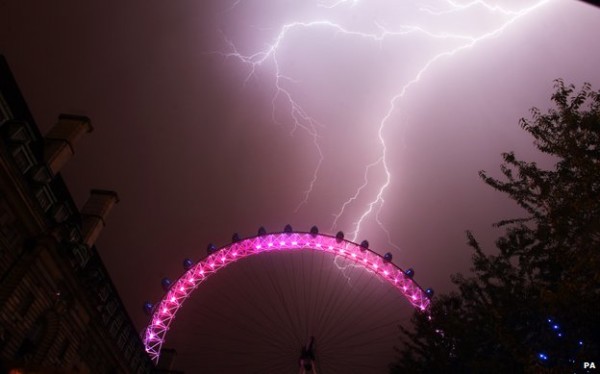Lightning is a discharge of static electricity that occurs when there is an imbalance in the electrical charge between the cloud and the earth’s surface.
Put very simply, it is a giant electric spark in the sky – a very powerful one. A single bolt could be a billion volts. It can stop a person’s heart and cook their internal organs.
On average three people die in the UK each year from lightning strikes, according to the Royal Society for the Prevention of Accidents (Rospa). In the US, deaths have been in decline but are still in the region of 30 a year. More than 85% of those killed are male.
In the UK, up to 60 people every year get struck and survive, but it’s estimated that more than three-quarters of them suffer some form of permanent disability.
So what is life like after being struck by lightning?
Eric Brocklebank, then 64, was struck on 9 June 2009 as he boiled sausages for a group of cadets at an event at RAF Digby.
He had just removed a metal barbecuing prong from the water and was holding it in the air when the strike happened.
‘Lightning trees’

- Lichtenberg figure – also known as “lightning tree” or “lightning flower” – is red, branching electric discharge pattern that occurs on the skin of strike victims
- Marks formed when delicate capillaries beneath skin rupture from shock of electrical discharge
- Usually appear within hours of incident and disappear within days; tend to occur on upper body
- Named after 18th Century physicist Georg Christoph Lichtenberg who described similar pattern while experimenting with static electricity
“A bolt of lightning came straight through the gap in the tent. It hit the fork I was holding. That melted into my hand.”
With lightning strike victims you can sometimes guess at the path of the electricity because of the formation of a Lichtenberg figure. Sometimes known as “lightning tree” or “lightning flower”, these intricate, fern-like patterns are caused by capillaries bursting.
In Brocklebank’s case, the lightning first caused a small wound in his wrist.
“Then it went down the right side of my body, across my hips and down through my left and right legs. It blew three holes in my right foot and two holes in my left foot.”
He was lucky to be surrounded by people who were able to help.
“As luck had it, all of the cadets knew CPR. One of the first people down there was my son. The first responders then worked on me for 20 minutes.”
More than three-quarters of lightning survivors suffer some form of permanent disability.
For Brocklebank, the consequences, four years after the strike, are both physical and mental.
He has scar tissue on his lungs and can be easily left short of breath. Sometimes his mobility is fine but occasionally he has to resort to a wheelchair. He is grateful for all the doctors and nurses who have worked on him over the years.
“I’ve had numerous exploratory examinations. I try to put a brave face on it. I’m not a person who lets things get me down.” He has retired from his job as a designer of X-ray systems, but still occasionally works. On one hospital visit he was told: “We don’t normally treat people with so many different problems.”
Men are four times as likely to be struck as women, says Rospa. This is believed to be because men are statistically more likely to be outdoors. Golfers are probably at greatest risk, because they are likely to be caught in the open far from shelter.
There are three types of lightning strike. A direct strike is when it hits you and goes to earth through you. A side flash is when it hits another object and jumps sideways to hit you. A ground strike is when it hits the ground then travels through it hitting you on the way
Safety tips when lightning strikes

- Seek shelter inside a large building or a car
- Get out of wide, open spaces and exposed hilltops
- If you have nowhere to shelter, make yourself as small a target as possible by crouching down with your feet together, hands on knees and head tucked in
- Do not shelter beneath tall or isolated trees
- If you are on water, get to the shore and off wide, open beaches as quickly as possible
- Studies have shown that proximity to water is a common factor in lightning strikes
Where does lightning come from?

Most lightning forms in the lowest portion of Earth’s atmosphere known as the troposphere.
It either travels between clouds as sheet lightning or from the clouds to the ground as fork lightning.
Lightning can also form in the ash clouds of volcanoes



Leave a reply